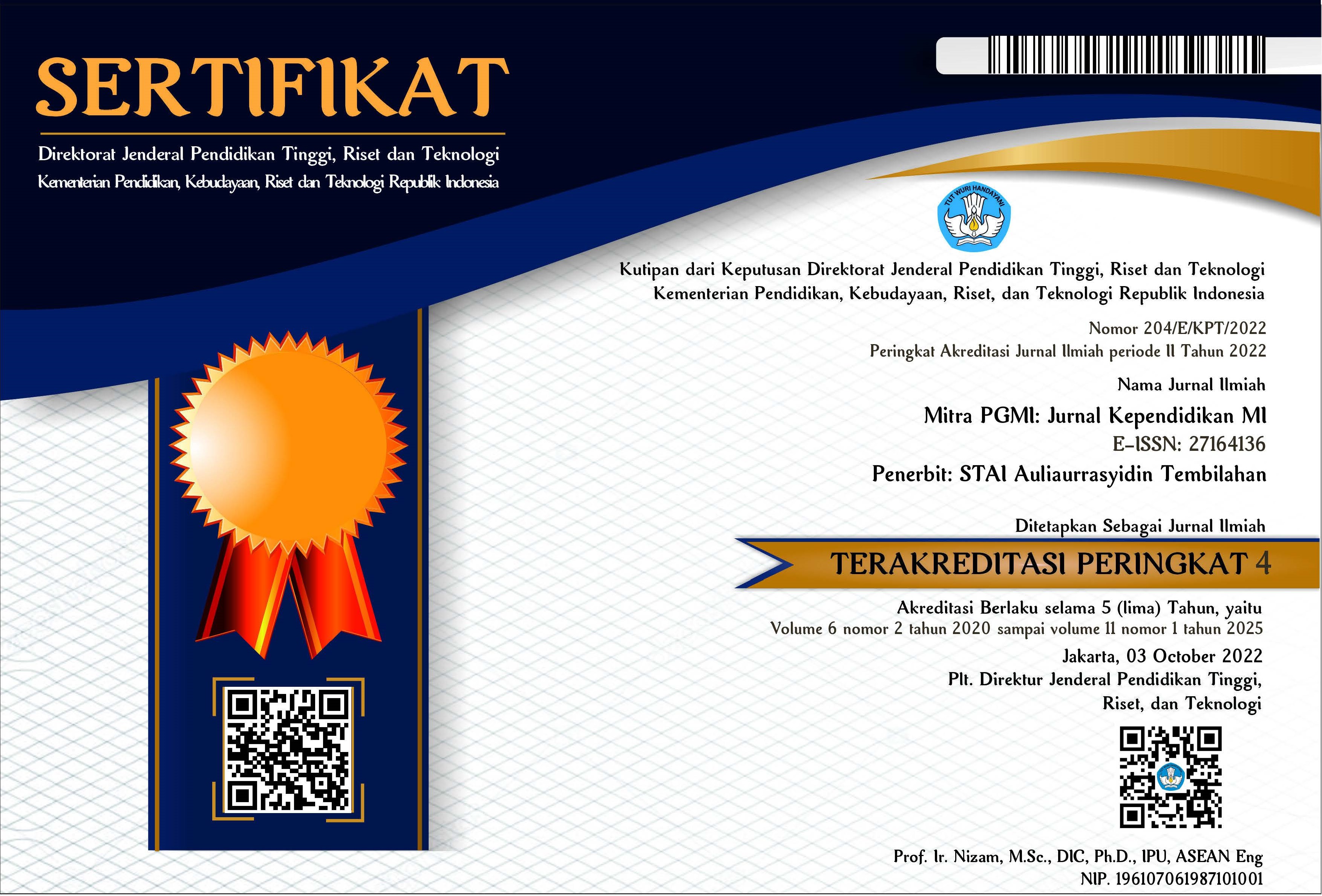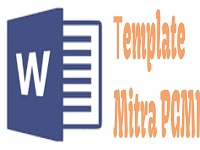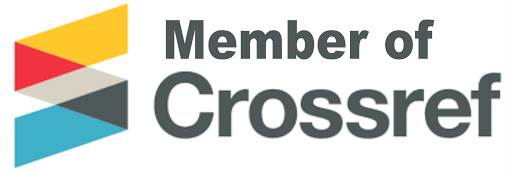Meningkatkan Pemahaman Konsep Matematika Siswa Sekolah Dasar melalui Pembelajaran Role Playing Berbantuan Uang Lipat (Uang Nilai Tempat)
DOI:
https://doi.org/10.46963/mpgmi.v10i1.1361Keywords:
Understanding Concepts, Mathematics, Role PlayingAbstract
Based on the results of pre-research observations at SD Negeri Depok 1 Sleman, it is known that some students have not reached the minimum completeness criteria (KKM) that have been determined by the school, namely 80. This research aims to determine the increase in understanding of Mathematics concepts for class II students at SD Negeri Depok 1 Sleman regarding addition. and reduction through role playing learning assisted by folding money. The research method used is classroom action research (PTK). Data collection for this research used test question sheets and teacher observation sheets. The data analysis method used is descriptive qualitative and and quantitative descriptive. The results obtained showed that teacher activity in cycle I was 66.67% (good) and increased in cycle II to 86.67% (very good). The average understanding of Mathematics concepts in cycle I obtained a score of 67 and increased in cycle II to 76.89. Completeness of the test results for understanding Mathematics concepts in cycle I was 57.14% and increased in cycle II to 78.57%. The results of this research indicate that the role playing learning model assisted by folding money media can improve students' understanding of mathematics concepts.
Downloads
References
Arviana, A., Syahrilfuddin, & Antosa, Z. (2020). Analisis penyebab rendahnya hasil belajar siswa pada mata pelajaran kelas IVB SD Negeri 147 Pekanbaru. Prosiding seminar nasional pendidikan guru sekolah dasar fakultas dan ilmu pendidikan Universitas Riau Pekanbaru.
Astrini, N. N. T., Sumantri, M., & Rati, N. W. (2018). Pengaruh Model Pembelajaran Role Playing Berorientasi Tri Kaya Parisudha Terhadap Hasil Belajar IPS Kelas IV. Jurnal Pendidikan IPS Indonesia, 2(2), 86–95.
Baeti, N. N., Prasetiyawati, D., & Priyanto, W. (2020). Keefektifan Model Pembelajaran Role Playing dengan Media Video Animasi Terhadap Kemampuan Pemecahan Masalah Matematika. Jurnal PGSD: Jurnal Ilmiah Pendidikan Guru Sekolah Dasar, 13(1).
Benu, G. (2021). Upaya Meningkatkan Hasil Belajar Matematika Tentang Operasi Hitung Bilangan Melalui Aalat Peraga Mata Uang. Jurnal Ilmiah Pendidikan TRISALA, 1(19). https://doi.org/10.54211/trisala.v1i19.201
Fauhah, H., & Rosy, B. (2020). Analisis Model Pembelajaran Make A Match Terhadap Hasil Belajar Siswa. Jurnal Pendidikan Administrasi Perkantoran (JPAP), 9(2). https://doi.org/10.26740/jpap.v9n2.p321-334
Fauzi, A., Sawitri, D., & Syahrir. (2020). Kesulitan Guru Pada Pembelajaran Matematika Di Sekolah Dasar. Jurnal Ilmiah Mandala Education, 6, 142–148.
Hamdi, S., Suganda, I. A., & Hayati, N. (2018). Developing Higher-Order Thinking Skill (HOTS) Test Instrument Using Lombok Local Cultures as Contexts for Junior Secondary School Mathematics. REiD (Research and Evaluation in Education), 4(2), 126–135.
Isrok’atun, & Rosmala, A. (2018). Model-Model Pembelajaran Matematika. Bandung: Bumi Aksara.
Kaharu, F. (2021). Penerapan Metode Problem Based Learning Pada Mata Pelajaran IPS Untuk Meningkatkan Minat Dan Hasil Belajar. Aksara: Jurnal Ilmu Pendidikan Nonformal, 7(2), 507.
Mawardi, A. D., & Aritonang, M. A. (2022). Efektivitas Pembelajaran Tematik Dan Model Pembelajaran Role Playing Terhadap Hasil Belajar Siswa Pada Sekolah Dasar Negeri 2 Bangkal. Pahlawan: Jurnal Pendidikan-Sosial-Budaya, 18(1).
Nusmasyita, P., Sirajuddin, & Satriani, S. (2023). Penerapan Metode Pembelajaran Role Playing Untuk Meningkatkan Hasil Belajar Statistika Siswa Sekolah Dasar. Jurnal Matematika dan Ilmu Pengetahuan Alam, 1(3).
Octavia, S. A. (2020). Model-Model Pembelajaran. Ciamis: Deepublish .
Octavia, S. A. (2021). Profesionalisme Guru Dalam Memahami Perkembangan Peserta Didik. Yogyakarta: Deepublish.
Puspendik. (2019). Pendidikan di Indonesia: Belajar dari Hasil PISA 2018. Jakarta: Pusat Penilaian Pendidikan Balitbang Kemendikbud.
Putri, N. P. W. P., Adar, M. A. S. Y., Solaifati, E., & Astitin, D. Y. (2022). Penerapan Metode Pembelajaran Role Playing untuk Meningkatkan Hasil Belajar Matematika Siswa Kelas III SD Negeri 4 Kaba-Kaba. Seminar Nasional (Prospek I).
Sanjaya, W. (2016). Penelitian Tindakan Kelas. Bandung: Kencana.
Setiyadi, D., Aviari, B. A., & Berliana, E. (2022). Uang Koin dan Kertas Mainan Sebagai Media Pembelajaran Matematika Kontekstual pada Sekolah Dasar. Jurnal Riset Pendidikan Dasar (JRPD), 3(2), 67. https://doi.org/10.30595/jrpd.v3i2.12853
Sudjana, N. (2018). Penilaian Hasil Proses Belajar Mengajar. Bandung: PT Remaja Rosda Karya.
Wijaya, T. U. U., Destiniar, & Mulbasari, A. S. (2018). Kemampuan Pemahaman Konsep Matematis Siswa Dengan Menggunakan Model Pembelajaran Auditory Intellectually Repetition (AIR). Prosiding Seminar Nasional Universitas PGRI Palembang, 431–435.
Downloads
Published
Issue
Section
License
Copyright (c) 2024 Lina Nur Azizah, Puji Rahmawati, Arif Wiyat Purnanto, Widya Widiania Ulfa

This work is licensed under a Creative Commons Attribution-ShareAlike 4.0 International License.
Authors who publish with this journal agree to the following terms:
1. Copyright on any article is retained by the author(s).
2. The author grants the journal, right of first publication with the work simultaneously licensed under a Creative Commons Attribution shareAlike 4.0 International License that allows others to share the work with an acknowledgment of the work’s authorship and initial publication in this journal.
3. Authors are able to enter into separate, additional contractual arrangements for the non-exclusive distribution of the journal’s published version of the work (e.g., post it to an institutional repository or publish it in a book), with an acknowledgment of its initial publication in this journal.
4. Authors are permitted and encouraged to post their work online (e.g., in institutional repositories or on their website) prior to and during the submission process, as it can lead to productive exchanges, as well as earlier and greater citation of published work.
5. The article and any associated published material is distributed under the Creative Commons Attribution-ShareAlike 4.0 International License








2.png)


